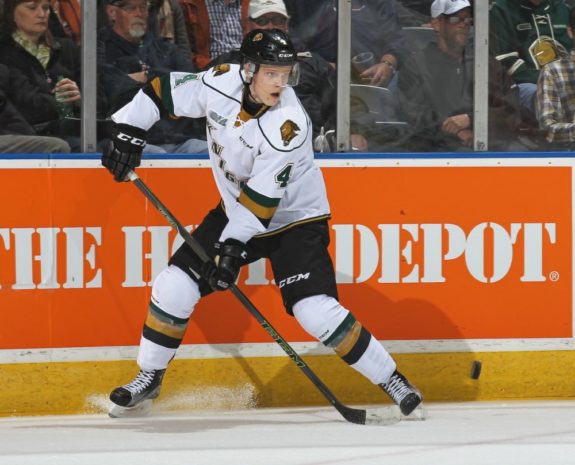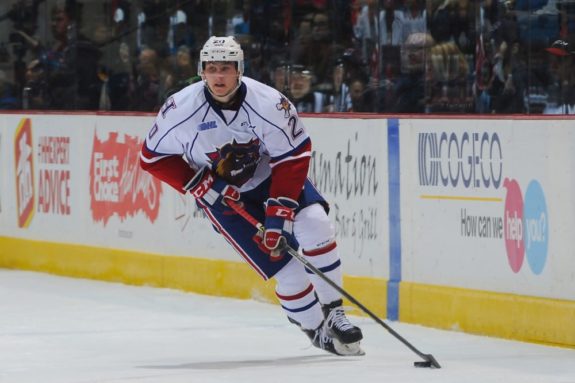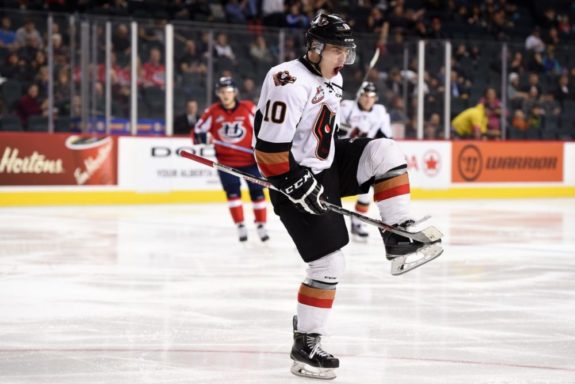On the whole, the Canucks’ drafting in the Jim Benning era has been solid. Of the 2015 class, first round pick Brock Boeser looks like a future top-six winger. Adam Gaudette meanwhile, could compete for a first-team slot as early as training camp. From 2014, the Canucks have a highly impressive record, selecting five players who are likely to play, or already have played consistently in the NHL. If it wasn’t for questionable asset management, the 2014 crop would form a big part of the Vancouver’s rebuild.
The 2016 Draft was a mixed bag however. On one hand, Vancouver added some decent prospects, but, bar Brett McKenzie, none have really exploded in their draft plus one year. In hindsight, some of these picks seem worse due to to players left on the board. Olli Juolevi, drafted at five, will likely excel in the NHL, but Matthew Tkachuk, drafted at six, already has. Vancouver didn’t help themselves by trading early picks either, losing the chance to draft in the second round. It’s entirely hypothetical, but keeping the assets flipped in the Eric Gudbranson trade could have left Vancouver with Jared McCann, and the chance to draft Alex DeBrincat at 33. For a team who desperately need scoring, this is an attractive thought.
With another huge draft on the horizon for the Canucks, it’s worth looking at their 2016 draft picks one year on. None have made the first team yet, but there is enough promise to fill a few gaps in the Vancouver prospect pool. Their progress this year will surely inform the Canucks’ decisions in Chicago.
Olli Juolevi
Defense – First Round (5) – London Knights (OHL)
Juolevi’s selection at number five wasn’t a huge surprise, considering the Canucks had few defensive prospects prior to his arrival. Immediately, the 6’3″ Finn shot to the top of Vancouver’s prospect depth chart. Canucks management locked down the young defenseman quickly, offering him an Entry Level Contract in early August.

Juolevi had a solid 2016-17 season in the OHL, logging big minutes for the London Knights. Despite his prominence, he did not blossom offensively in the way that Vancouver management might have hoped – scoring 42 points in 58, which equals his performance in his draft season (42p 57gp). He had a controversial outing as Captain of Finland at the World Juniors, playing limited minutes, and registering a subpar two assists in six games. Ultimately, the Finns crashed out in ignominious fashion. In his own end, Juolevi still looks assured, intelligent and highly competent, so it would be unfair to say he has regressed. He definitely hasn’t set the world alight though.
At this point, Juolevi looks likely to have a prosperous career in the NHL, and the tendency to compare him to Tkachuk is unfair. However, the lack of progress on his points-per-game rate is concerning, and in hindsight, his numbers as an OHL rookie could have been inflated by London’s dynamic offensive core in 2015-16. In sum, Juolevi is an excellent defensive prospect, but doesn’t project as an elite quarterback or point shooter. This makes drafting an offensively-minded blueliner a priority for the Canucks in Chicago.
Juolevi will attempt to break the Canucks lineup at training camp this year, and will probably return to the OHL if he is unsuccessful.
William Lockwood
Wing – Third Round (63) – Michigan (NCAA)
The Canucks drafted Lockwood early in the third round. Currently Lockwood plays for the Michigan University Wolverines, and will likely remain there next season.
Lockwood was recruited after a decent season with the US National Team Development Program, scoring 33 points in 59 games. This is not an overwhelming total for an early third round pick, but the Michigan native is more of a two-way guy by trade. Lockwood plays aggressively and proactively, and is not deterred from going to the boards by being slightly undersized (5’11”). At Michigan, Lockwood had a good first season in the NCAA scoring 20 points in 30 games. Overall, the Canucks’ third round pick hasn’t blown up – but he has done enough to merit his selection at 63.
Described as a “hard-nosed two-way winger” by Elite Prospects, Lockwood projects as a gritty forward who could fill the gap left by Jannik Hansen in the Canucks’ forward corps. It’s hard to find much wrong with Lockwood’s progress, but he may have been a reach at 63. Prospects such as Vitaly Abramov, and Adam Fox (drafted 64 & 65) all seem to have a higher ceiling. Considering around one in three players drafted in the third actually make the NHL though, there will be little complaint if Lockwood continues to progress well.
Lockwood, and potentially Brett McKenzie, could form the backbone of an extremely strong bottom-six for the Canucks rebuild. With a team sorely lacking offensive talent however, Vancouver should draft with more upside in the third this year.
Cole Candella
Defense – Fifth Round (140) – Hamilton Bulldogs (OHL)
Cole Candella was Vancouver’s sole pick in the fifth round. Drafted from the Hamilton Bulldogs in the OHL, Candella remained there for the duration of the 2016-17 season. Currently, he is yet to sign an entry level contract.

Candella seemed like a shrewd pick by the Canucks in the fifth. The defenseman enjoyed a breakout draft year in Hamilton, playing effectively and intelligently in all three zones. Fresh from scoring 20 in 37 in 2015-16 however, Candella’s production imploded last season, notching the same total in 65 games. In his own end, Candella has always been prone to lapses of concentration, and his only average shut-down play makes it difficult to see him turning carving out a niche as a defensive defenseman. He is still highly mobile, but his stagnation on the forecheck has stunted his development.
Currently the future doesn’t look good for Candella, although a return to form next season would make a real difference. He is worth keeping an eye on and might do enough for a place in Utica come 2018-19.
Jakob Stukel
Wing – Sixth Round (154) – Calgary Hitmen (WHL)
The Canucks called Jakob Stukel early in the sixth round. This was Stukel’s second draft-eligible year, but the first in which he drew serious attention. Playing with the Calgary Hitmen, Stukel notched 34 goals and 56 points in the 2015-16 season.

The Canucks’ strategy in the late rounds of the draft was recruiting in-form over-agers, of which Stukel was the first. As said before draft-day, Stukel is an out-and-out scorer, with dynamic skating and a good toolkit of shots at his disposal. Playing in his third WHL season this year, Stukel had a small drop off, scoring 53 points in 70 games.
Stukel is a boom-bust pick. He offers no two-way ability, and either projects as a professional scorer, or nothing at all. At the moment, he leans towards the latter as he has not tormented defences in the WHL as regularly as you would expect from a twenty-year-old. That isn’t to say he was a wasted pick. Ultimately, Vancouver will need to take some gambles to rebuild successfully. It’s unlikely though that Stukel will pan out.
Rodrigo Abols & Brett McKenzie
Centre – Seventh Round (184 & 194) – Arcadie Bathurst Titan / North Bay Batallion
In Rodrigo Abols & Brett McKenzie, Vancouver drafted two extremely similar players. Both are overage, and both are regarded as defensive, hard-nosed forwards. Age difference is a factor here however, and whilst McKenzie’s 67 in 67 in the WHL at 20 years old is a real step forward, it’s hard to get excited about Abol’s 50 in 52 at 21 in the QMJHL.
All in all, McKenzie has been the biggest surprise in Vancouver’s 2016 draft class. His age does mitigate his scoring somewhat, although it’s worth noting that the 20-year-old is playing on an average Battalion team, as the only drafted forward. Consequently, Dobber Scouting mention that McKenzie played most of the Battalion’s tough minutes. McKenzie’s deployment and his solid production suggest a player beginning to consistently generate scoring against strong opposition, without relying on talented teammates. Coupled with his ability on the backcheck, he looks to have a variety of tools made for the professional game. If he refines his penalty-killing ability and his checking game further, McKenzie could make a real impact in Vancouver’s bottom-six.
Abols meanwhile is a frustrating selection as he is not dissimilar to McKenzie. Furthermore he would have become a free agent on July 1, 2016 – only six days after the draft. Picking two identical players in one round is bizarre, especially considering some of the tempting alternatives available in the seventh. David Quenneville will be impeded in his hockey career by his size (5’8″), but a first-year defenseman who scores 55 points in 65 is a more attractive proposition than over-stocking on fourth line centres. Persistent low-risk drafting in the late rounds isn’t a disaster, but it creates missed opportunities. This year, the Canucks should take more risks late on.